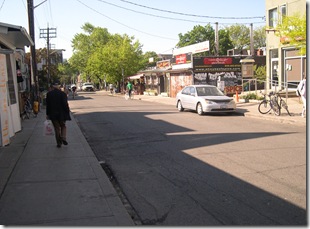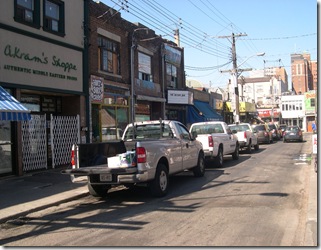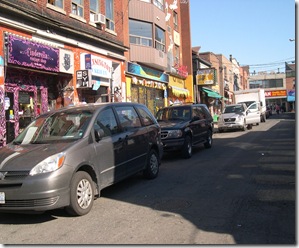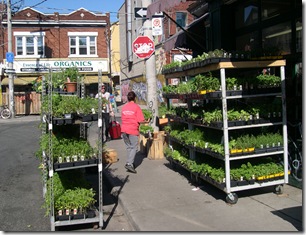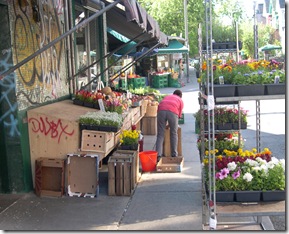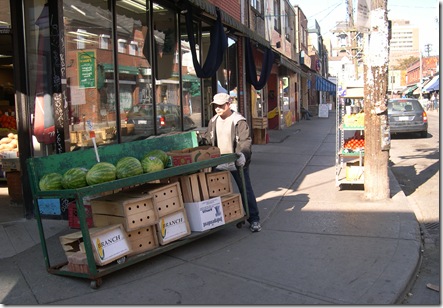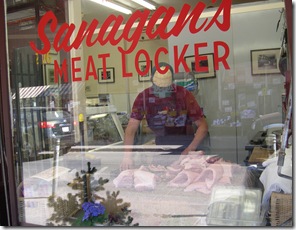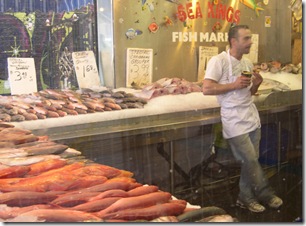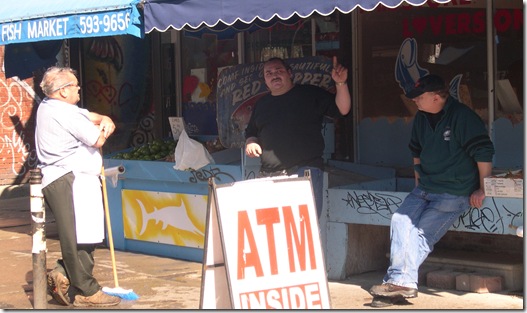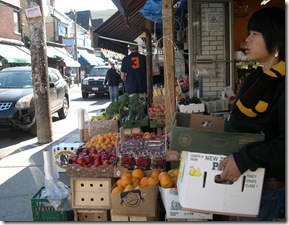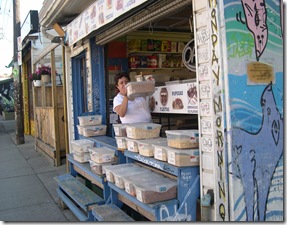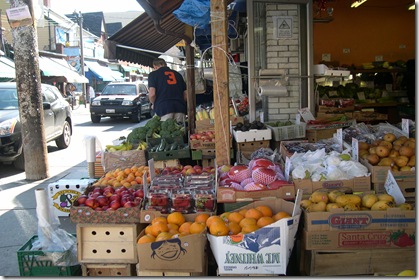On a recent spring morning in June, I strolled the Kensington Market. Warm air drifted on the breeze under a sunshine-filled sky. The tranquil scene was disturbed only by a voice shouting across an empty street to enquire if a fellow worker wished to meet him for a caffeine boost in the sidewalk patio of the Moon Bean Cafe. Other workers joked in raunchy tones as they enjoyed their take-out cups of java in front of their places of work. Sound ideal? It was if I ignored the slight smell of garbage from the previous day. Even the French know that some perfumes linger longer than others.
As I walked along the street, shop owners were arranging fruits and vegetable in display boxes. Fish of every size and colour, and later in the day odoriferous emissions, were being placed in shop windows. In a butcher store on Baldwin Street, meat was being trimmed, and at a sidewalk stall that specializes in dried beans, pasta, rice and spices, an elderly woman was putting out numerous plastic bins on wooden crates that lined the sidewalk in front of the store.
The warmth of the early-day sun felt pleasant against my bare arms. Nothing is as promising in life as early morn on a sunny June day. Except perhaps a wild night in the entertainment district, where more than arms are bare. I do not speak from personal experience, but express only what I have been told by my more astute friends. I might add that they are younger than I.
Entering the Moon Bean Cafe, I noticed that on the washroom wall a graffiti writer of infinite wisdom had inscribed the words, “Live Lies to the Fullest.” This ringing endorsement of the proverbial art of “bull-shitting” is surely the motto of many a politician. In some respect, it might apply to huskers anywhere that propagate philosophies that are deeply flawed. Some believe that the bigger the lie, the more it is believed. Our recent federal election provided Canadians with ample proof of this philosophy. Following the opening of parliament, the government trumpeted to the press that because it now has a strong majority, it has the authority to implement its policies unopposed. The fact that 60 percent of voter rejected this government, they never mentioned. Yes indeed, “Live lies to the fullest.”
After my coffee, walking north on Kensington Avenue, I overheard a loud conversation between a market eccentric and her imaginary psychiatrist. The woman, who was quite alone, was intensely engaged in airing her complaints against her doctor. She argued, “You tell me that I have delusions of grandeur because I believe that I’m an opera singer.” Then she added scornfully. “Then let me let you a thing or two. You have delusions of grandeur when you think you’re a psychiatrist. I’ve heard your advice. Believe me, you’re no psychiatrist. And I might add, my singing is better than your advice.”
As I crossed the street, I thought that the woman was quite likely correct. Perhaps the newly-elected government should have a talk with her. After all, she is an expert on “delusions of grandeur.”
Man, I love the Kensington.
Photos of Early Morning in the Kensington Market
Augusta Avenue, gazing south
In contrast to the first picture, by 8:30 am Kensington Avenue and Baldwin Street are lined with cars and trucks, mainly of those who either own businesses or work in the shops of the market. However, the merchants are against turning the avenues of the Market into walking streets, as they claim that the parking spaces are required for their customers. “Live lies to the fullest.”
If walking street became a reality, delivery trucks and those with handicapped permits could still be allowed to enter the streets.
Plants being set out at the corner of St. Andrews and Kensington avenues. Nothing is so glorious as purchasing seedlings in spring, while dreaming of July’s luxurious blooms, and imagining the spreading fullness of the August growth. I will avoid discussing the “spreading fullness” implied in “living lies to the fullest.
Fruit being set out for the day at the corner of Kensington Avenue and Baldwin Streets.
Preparing the daily supply of meat Morning coffee before the customers arrive
Chatting in the warm air of June, as the man in the centre salutes the photographer. Please note that it is not the index finger.
Shops preparing the displays for the stalls on Augusta Avenue.
Thoughts on the Kensington Market from the book The Villages Within which contains a walking tour of the market.
Torontonians do not usually refer to the Kensington Market as a “village.” The dictionary defines a village as “a group of homes that is larger than a hamlet and smaller than a town.” However, as anyone who has experienced the villages of Ontario can verify, a village is much more than this. Villages have boundaries, alerting travelers when they have arrived within its precincts and when they have departed. Every village has a different character and an atmosphere that throughout the decades the villagers have created.
This is true of “Kensington.” The residents tend to be community oriented, many of them maintaining a keen sense of neighbourhood. Although they have valves that they hold in common, they also have a true sense of individualism. Many of the residents are environmentalists, enjoy health foods, and strongly support recycling. As well, many ethnic groups reside within the area.
Others are aging hippies, leftover flower children, and leather types. Some follow lifestyles that defy categorization. Yet there are also those whose lifestyle is indistinguishable from other residents of the city. It is evident that a few are restoring their homes to capture the appearance of the nineteenth century, rather than simply renovating, as they have a keen interest in the history of the area. The Market has a few colourful eccentrics who are well accepted and considered an integral part of the scene.
Other cities in the world have districts within their boundaries that are similar to Kensington, forming small enclaves that maintain their unique character despite the passage of time. They too share common characteristics, but no two are ever alike. Although many have historic homes and quaint shops, nowhere is there another Kensington.
It is “one of a kind”—a chaotic collage of diversity.
Richard Florida, in his book The Rise of the Creative Class, discusses places where the residents are seeking an environment that is open to differences, where highly creative people are welcomed, regardless of ethnic background, income, creed, or sexual orientation. They prefer locations where there multiplicity is accepted, where odd personal habits or extreme styles of dress are not only welcomed, but also celebrated. Unusual marital arrangements and varied partnership relations fail to attract any attention.
Kensington is such a place, and is truly “a village within.”
